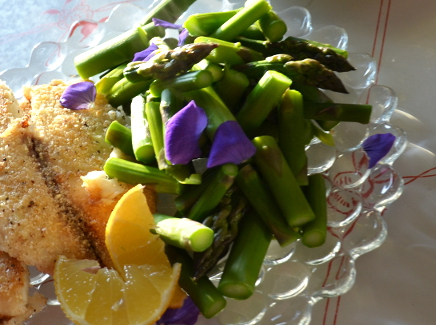Asparagus
Asparagus is the very first homegrown crop here at Kirby's. It begins to poke out of the ground in the cold dampness of Spring, and then shoots into the air as the weather warms up. Grandpa Kirby used to say that you could watch it grow when it was hot enough! Along with Rhubarb, it's one of the only perennial vegetables grown in Western New York.
Season: May - Early June
Recipe:
Simple Sauteed Asparagus (pictured above with cornmeal crusted tilapia)
Asparagus, Goat Cheese, and Lemon Pasta from Smitten Kitchen
Roasted Asparagus from epicurious.com from Smitten Kitchen
Storage
Store asparagus in your refrigerator (the crisper drawer is a good spot) wrapped in plastic. Give it a good rinse before you wrap it to avoid dehydration, and place a moist towel around the bottom. You could also put your bunch of asparagus in a jar with an inch or so of water.
Asparagus is best when eaten within 2-3 days (for both flavor and nutrition value) but it will last up to two weeks when stored properly.
Longterm Storage: If you would like to enjoy this Spring vegetable during the winter, simply blanch it, put it in freezer bags, and freeze immediately.
Preparation
- Steaming, boiling, and roasting or grilling are the most popular ways to prepare asparagus but you can also eat it raw. Add it to a salad or serve it with dip.
- Add to boiling water or a steamer and cook for 5-8 minutes.
- It takes 3-5 minutes to stir fry or pan fry. Asparagus is wonderful with so many flavor combinations!
About Asparagus...
History
Asparagus makes it's first appearance in recorded history in Ancient Egypt. It was enjoyed in Ancient Greece as well, for both it's medicinal and culinary properties, before slowly spreading north into Europe during the 14th and 15th century. King Louis XVI built a greenhouse just for asparagus, and Emperor Augustus had a fleet of ships dedicated to transporting it.
Information
Some interesting facts about asparagus from the Michigan Asparagus Board (asparagus.org):
- Asparagus is a member of the Lily family (but according to wikipedia, it's been reclassified into the family Asparagaceae).
- Asparagus spears grow from a crown that is planted about a foot deep in sandy soils.
- Under ideal conditions, an asparagus spear can grow 10" in a 24-hour period.
- Each crown will send spears up for about 6-7 weeks during the spring and early summer.
- The outdoor temperature determines how much time will be between each picking...early in the season, there may be 4-5 days between pickings and as the days and nights get warmer, a particular field may have to be picked every 24 hours.
- After harvesting is done the spears grow into ferns, which produce red berries and the food and nutrients necessary for a healthy and productive crop the next season.
- An asparagus planting is usually not harvested for the first 3 years after the crowns are planted allowing the crown to develop a strong fibrous root system.
- A well cared for asparagus planting will generally produce for about 15 years without being replanted.
- Asparagus is a nutrient-dense food which in high in Folic Acid and is a good source of potassium, fiber, vitamin B6, vitamins A and C, and thiamin.
- Asparagus has No Fat, contains No Cholesterol and is low in Sodium
Nutritional Facts
(More from the Michigan Board of Asparagus)
“Asparagus is one of the most nutritionally well-balanced vegetables in existence. It leads nearly all produce items in the wide array of nutrients it supplies in significant amounts for a healthy diet.
Asparagus is the leading supplier among vegetables of folic acid. A 5.3 ounce serving provides 60% of the recommended daily allowance for folacin which is necessary for blood cell formation, growth, and prevention of liver disease. Folacin has been shown to play a significant role in the prevention of neural tube defects, such as spina bifida, that cause paralysis and death in 2,500 babies each year. Its wealth of nutrients, fiber and very low sodium and calorie content make asparagus a nutritionally wise choice for today's health-conscious consumer.
Low in calories, only 20 per 5.3 oz. serving, less than 4 calories per spear."

